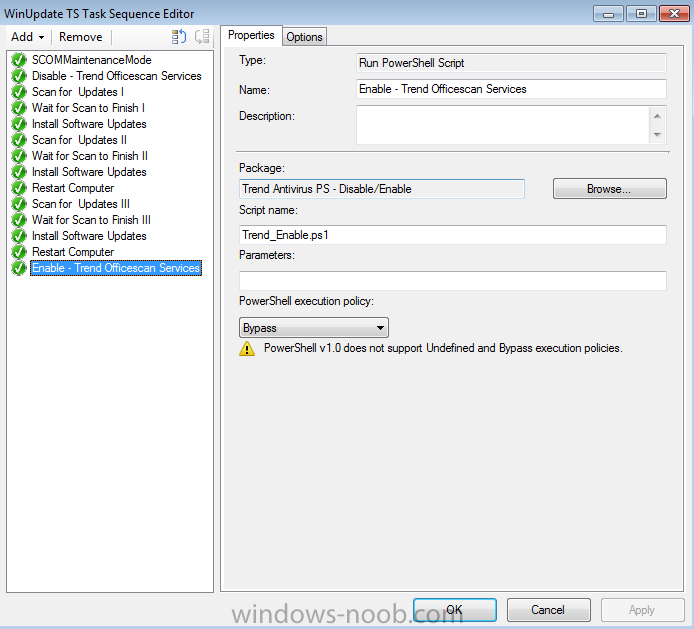Search the Community
Showing results for tags 'Windows update'.
-
Hello Everyone, I want to get in the habit of cleaning up my SUGs created by my ADRs. I'd like to do this every 6 months but I've run into a problem. Within one of my ADRs, for example, I have the following set for the 'Title' options: -Preview -Security Only Quality Update...
- 1 reply
-
- software updates
- windows update
-
(and 3 more)
Tagged with:
-
Good Morning, I am not currently utilizing WSUS, however, I was wondering if it was at all possible to utilize the same pre and post installation windows updates that are present in MDT 2013?
- 2 replies
-
- sccm
- windows update
-
(and 1 more)
Tagged with:
-
If I take a machine from the office to home, the Configuration Manager does show Internet. We have a management point on the DMZ that the machine connects to get a list of updates. It looks like the workstation is making communication with that server based on the logs. What is not happening is t...
-
- sccm 2012
- internet client
-
(and 1 more)
Tagged with:
-
Hi, I have created a TS to disable the antivirus (Trend - PS script) and then do a Software Update cycle and install Windows Updates on our servers - see: The plan is to reduce manual intervention and hours of work, watching and waiting - for our manual servers (ie clusters etc) H...
-
- sccm
- windows update
-
(and 1 more)
Tagged with:
-
I'm having some problems with downstream servers syncing with the upstream server. All WSUS Servers are WSUS Server Version: 3.2.7600.256 and I have installed KB2720211 and KB2734608. The Database is held in the Windows Internal Database The Upstream server is synchronising with Windows...
- 1 reply
-
- WSUS
- server 2008 r2
-
(and 3 more)
Tagged with:
-
Hey, i have sort of a very strange problem, maybe someone is able to help me or at least tip me into the right direction on what i am doing wrong. We are running a SCCM2012 R2 CU3 environment. We deploy our Software and OS with it since Win7 without any issues. Now with Tablets emerging we o...
-
- Windows 8.1
- SCCM 2012 R2
-
(and 2 more)
Tagged with:
-
Hello, I have about 8 labs (Windows 7, ~20-35 machines per each lab) spread across campus. These labs have Deep Freeze on them. We've recently started implementing SCCM 2012. What would be the best practice to update these machines that are frozen across campus? Each lab currently has their...
- 1 reply
-
- deep freeze
- frozen
-
(and 4 more)
Tagged with:
-
ZTI OSD downloading updates from MS, not SCCM server
Aurock posted a question in Deploying Operating Systems
I recently upgraded our SCCM server from 2012 SP1 to 2012R2. Since then, I've been struggling to get OSD working again. After creating a new task sequence, with new versions of the packages for USMT, settings, deployment tools, etc, I've got it mostly back up and going. The trouble now is that th...-
- OSD
- Windows Update
-
(and 1 more)
Tagged with:
-
I'm running 2012 SP1 and I have an ADR setup for my workstations to automatically download and install. I'd like to handle the servers differently. Is it possible to configure the servers to simply download the patches but only install when I choose to? I know I can do this with WUS, but is it pos...
- 2 replies
-
- windows update
- sccm 2012sp1
-
(and 1 more)
Tagged with:
-
I am implenting ADR for patch managment and I am having a bit of a Property filter issue. I would like to create an ADR that creates monthly deployments for my patch managment that I have control on when deploying. So I have checked Create new Software Update Group under general and cleared the...
- 3 replies
-
- Automatic Deployment Rules
- ADR
-
(and 2 more)
Tagged with:
-
Ok, I have several possible issues that I will place in order here and would like some asisstance if possible! I have SCCM 2012 installed on 1 server, WSUS on another server. I had to uninstall IIS/WSUS on server and reinstalled it because it was failing to sync with SCCM server When I reinsta...
-
Hi, Could someone please help me better understand how the compliance report actually determines which machines are compliant and not compliant. i have a sccm 2007 r3 wsus and mdt 2010 integration environment.... we have around 75% machines compliant and around 20% machines none complian...
-
Hello, I am deploying windows updates to a collection of testcomputers before i deploy them to the whole company. But what if an update would mess with some of our applications. How do i remove them through the SCCM? I use SCCM 2007 // Barty




